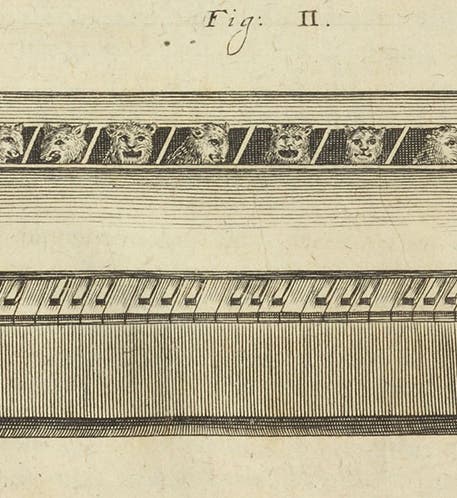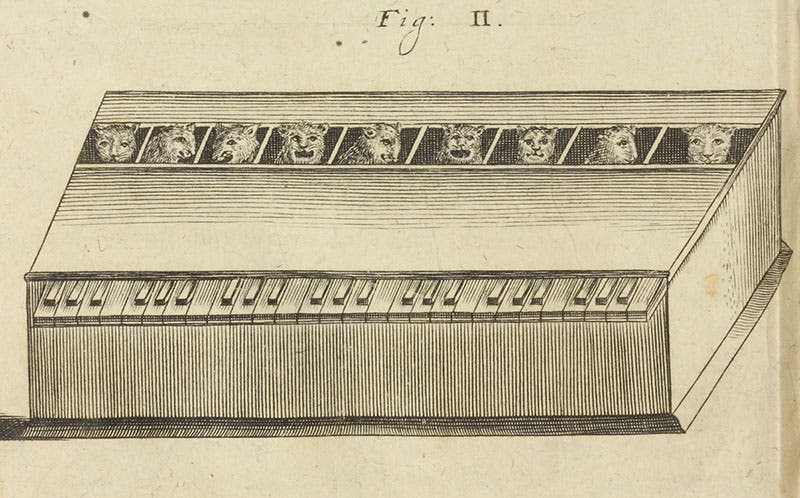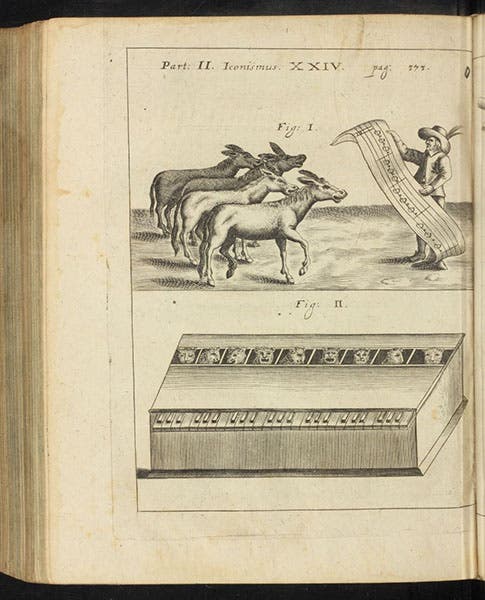Scientist of the Day - Gaspar Schott
Gaspar Schott, a German Jesuit natural philosopher, was born Feb. 5, 1608. We celebrated Schott's birthday in a post 9 years ago, but we have a reason for lighting another candle today for the good Father. The thrust of our earlier post was that Schott was industrious (a publishing machine, we called him) and that he was especially interested in marvelous mechanical devices, such as magic lanterns and perpetual-motion machines. Today we look at one particular device from his encyclopedia of natural magic, Magia universalis naturae et artis (4 vols., 1657-59). The device is the infamous cat piano.
Schott says he learned about it from his fellow Jesuit, Athanasius Kircher (an even greater publishing machine). Kircher, in his Musurgia universalis (1650), had described an instrument intended to perk up a certain German prince who was always depressed. It consisted of a keyboard attached to a compartment containing a line-up of cats; when a key was depressed, it poked the associated cat in the tail with a tack, producing a outraged note. An arpeggio on the keyboard thus would have evoked a true cat-caphony of sound, which supposedly brought a smile to the face of the prince (second image). Kircher did not illustrate his described instrument, but Schott did (first and third images). It is the first recorded illustration of the cat piano, which, since there was as yet no piano, was called a cat organ. The other instance of animal music illustrated by Schott, the donkey quartet (the music-reading, donkey quartet, yet) will have to wait its turn for explication on some future occasion.
The cat piano disappeared into the maw of history as quickly as it had emerged, and we hear no more about it for 225 years, when it suddenly re-surfaced in 1883 in the pages of the French journal La Nature, in a short article on “Un orchestra de chats” by a mysterious "Dr. Z.", an aspiring plagiarist, accompanied by a wood engraving (fourth image). The braying donkeys appear as well, but, like the text of the article, they are just copied from Schott's book, and they have been moved to the bottom. The cat piano, however, has been completely redrawn and given top billing. It looks much more like a real instrument than Schott’s original sketch, although it still has more keys than cats (see detail, fifth image). Perhaps some of them also caterwaul falsetto, in a higher register, when doubly stimulated, rather like Tuvan throat-singers.
The cat piano then disappeared once again, but fortunately, not forever. In 2009, two Australians, Eddie White and Ari Gibson, released a short animated film, The Cat Piano, in which our instrument takes center stage. A city of 4000 cats, in which music is the primary raison d’etre, is being slowly silenced, as singing cats are kidnapped one by one by some malevolent force. All evidence points to the keeper of an offshore lighthouse, where the wailing of cats can be heard. An omniscient feline narrator tells us that the keeper (a human) has erected a colossal cat piano in his lighthouse, with so many keyboards it was truly a cat organ, and he has been gradually filling its vacancies with musical felines. When the love of our narrator’s life is abducted, the town springs into action. Cat lovers will be relieved to hear that by the time the 8-minute film comes to an end, the villain has been vanquished, the cats liberated, and the city is alive with music once again.
The film must have struck a chord among critics, for it won numerous awards for Best Animated Short in Australia for 2009. You may view the complete 8-minute film on YouTube, deliciously narrated by Nick Cave. Unless you work in a cat hospital, it is probably NSFW. While the narrator does tell us that the idea for the cat piano was ripped out of the history books, and we do see a brief glimpse of an old tome, it is an imaginary one, and there are no kudos thrown Schott’s way in the credits. So I suspect that few of the 1.1 million viewers are aware that the origins of the film lay in the encyclopedic musings of two 17th-century, musically-minded, Jesuit scientists. You are now among those few.
William B. Ashworth, Jr., Consultant for the History of Science, Linda Hall Library and Associate Professor emeritus, Department of History, University of Missouri-Kansas City. Comments or corrections are welcome; please direct to ashworthw@umkc.edu.












